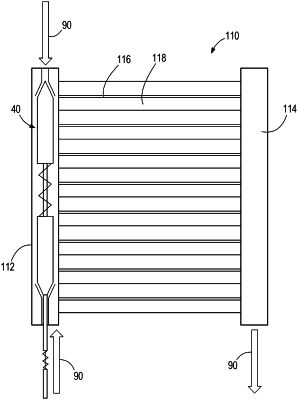| CPC F25B 41/345 (2021.01) [F25B 39/028 (2013.01); F25B 2600/2513 (2013.01)] | 16 Claims |

|
1. A method for disrupting a flow of refrigerant through a heat exchanger, the method comprising:
receiving, with a controller, a first signal from a first sensor, the first signal indicative of a pressure of the refrigerant flowing through the heat exchanger,
receiving, with the controller, a second signal from a second sensor, the second signal indicative of a temperature of the refrigerant,
setting, with the controller, an operating frequency of a valve based on the first signal and the second signal, wherein the valve regulates refrigerant flow through the heat exchanger, and wherein the operating frequency includes a rate at which the valve actuates between a first valve position that sets a first refrigerant flow rate through the heat exchanger and a second valve position that sets a second refrigerant flow rate through the heat exchanger, and
controlling, with the controller, operation of a solenoid to actuate the valve at the operating frequency,
wherein the refrigerant includes refrigerant in the liquid phase and refrigerant in the gaseous phase, and
wherein actuating the valve at the operating frequency disrupts the flow of the refrigerant through the heat exchanger such that when the valve is moved from the first valve position to the second valve position, the refrigerant in the liquid phase is more equally distributed through the heat exchanger.
|
|
8. A control system for disrupting a flow of refrigerant through a heat exchanger, the control system comprising:
a valve for regulating the flow of refrigerant through the heat exchanger,
a solenoid coupled to the valve that actuates the valve;
a first sensor that provides signals indicative of a pressure of the flow of refrigerant within the heat exchanger;
a second sensor configured to provide signals indicative of a temperature of the refrigerant; and
a controller coupled to the solenoid and the sensor, the controller including an electronic processor and a memory, the controller configured to:
receive a first signal from the first sensor,
receive a second signal from the second sensor,
set an operating frequency of the valve based on the first signal and the second signal, wherein the operating frequency includes a rate at which the valve actuates between a first valve position that sets a first refrigerant flow rate through the heat exchanger and a second valve position that sets a second refrigerant flow rate through the heat exchanger, and
control operation of the solenoid to actuate the valve at the operating frequency,
wherein the flow of refrigerant includes refrigerant in the liquid phase and refrigerant in the gaseous phase, and
wherein actuating the valve at the operating frequency disrupts the flow of the refrigerant through the heat exchanger such that, when the valve is moved from the first valve position to the second valve position, the refrigerant in the liquid phase is more equally distributed through the heat exchanger.
|
|
15. A heat exchanger assembly comprising:
a heat exchanger core including a refrigerant channel, an inlet manifold, and an outlet manifold;
a valve configured to regulate refrigerant flow into the heat exchanger core,
a solenoid that actuates the valve between a first valve position that sets a first refrigerant flow rate through the heat exchanger core and a second valve position that sets a second refrigerant flow rate through the heat exchanger core;
a pressure sensor configured to provide pressure signals indicative of a pressure of refrigerant within the refrigerant channel;
a temperature sensor configured to provide temperature signals indicative of a temperature of refrigerant within the refrigerant channel; and
a controller including an electronic processor and a memory, the controller configured to:
receive a first signal from the first sensor,
receive a second signal from the second sensor,
set an operating frequency of the valve based on the first signal and the second signal, wherein the operating frequency is the rate at which the valve actuates between the first valve position and the second valve position, and
control operation of the solenoid to actuate the valve at the operating frequency.
|